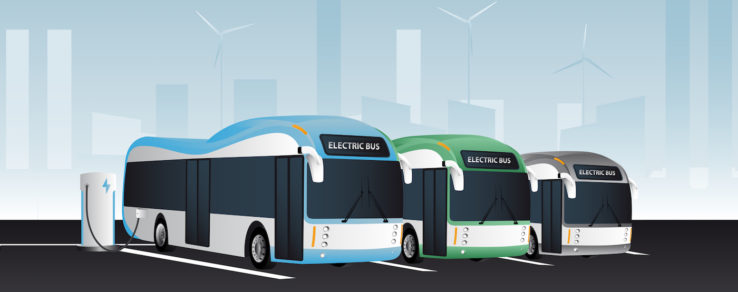As an increasing number of U.S. cities focus on climate goals, city leaders are taking steps to reduce greenhouse gas emissions from public transportation systems. One of these environmentally friendly initiatives is the electric bus. Transit agencies across the country — from Seattle, Washington, to Portland, Maine — are beginning to incorporate this innovative technology into their fleets.
A sustainable solution
With environmental concerns growing in importance, city leaders are considering the impact of public transportation, including emissions from traditional diesel buses. In dense urban areas, bus exhaust is also a major health concern for citizens. In the U.S., the transportation sector makes up nearly 30% of total greenhouse gas emissions.
Electric buses are one solution to counteract this negative environmental impact. Currently, there are about 650 electric buses on U.S. roadways — a small fraction of the total number around the globe. About 425,000 electric buses are in use worldwide, with 99% of them operating in China. Recognizing the advantages of the technology, U.S. cities are beginning to catch up by moving forward with clean public transit initiatives.
A recent study finds nearly every state transit agency owns, or will own in the future, at least one electric bus. Showcasing this growth, the number of zero-emission buses in 2019 increased nearly 37% from the previous year.This number will continue to rise in the years and decades to come. In fact, several major metropolitan areas have long-term commitments to replace their fleets with battery-powered buses, including Los Angeles by 2030, San Francisco by 2035 and New York by 2040.
Benefits of electric buses
According to the Environmental and Energy Study Institute (EESI), electric buses offer many benefits over diesel-fueled versions — notably zero carbon emissions. They are also quieter, easier to maintain and have lower operating costs.
Just like charging a personal electric vehicle, electric buses utilize power from the U.S. electrical grid. However, some parts of the grid are more advanced than others, with greater reliance on renewable energy resources. A recent study finds that electric buses have lower carbon emissions than diesel buses in all regions of the country. As the U.S. electrical grid becomes cleaner and more diverse, cities will see even more positive impact from electric bus implementation.
Forward-thinking cities
With a commitment to sustainability, the Port Authority of Allegheny County (Pennsylvania), in partnership with local energy utility Duquesne Light Company, purchased two new electric buses in March 2020. Duquesne installed fast chargers and electrical infrastructure to support the buses, which travel to and from downtown Pittsburgh. The Port Authority shares data on the buses, which gives the utility valuable insights into the demand on the electrical grid. They plan to purchase additional electric buses for a new downtown bus route.
King County, Washington, has been leading the country in battery-powered public transportation. The county, which includes Seattle, has 185 zero-emission buses with a range of about 140 miles per charge. The county is working with local utility Seattle City Light to ensure the power needs are met for the advanced electric infrastructure. An early adopter of electric buses, the county has an aggressive goal of 100% renewable energy-powered public transit by 2040.
In Austin, Texas, the Capital Metropolitan Transportation Authority (Capital Metro) purchased two electric buses. The battery-electric vehicles feature zero-emission technology, and will help reduce the city’s carbon footprint. This is just the start of cleaner transportation in Austin; the transportation authority has plans to purchase 80 electric buses in the next five years.
Overcoming speed bumps for electric buses
Perhaps the biggest challenges for electric bus adoption are high upfront costs and range anxiety. While many transit agencies are apprehensive about the higher upfront costs (approximately $770,000 per vehicle versus $445,000), EESI finds that powering electric vehicles is 2.5 times less expensive than diesel.
With improving battery technology, most electric buses nowadays have a range of 225 miles and can operate all day on one charge. Charging infrastructure requires construction buildout, which is both expensive and time-consuming. However, with the right partnerships, including coordination with local utilities and other city partners, these concerns can be mitigated.
As barriers continue to break down and cities make the environment a priority, it is clear that electric buses are here to stay for the long haul.

